ISIS destroying another ancient archaeological site in Iraq
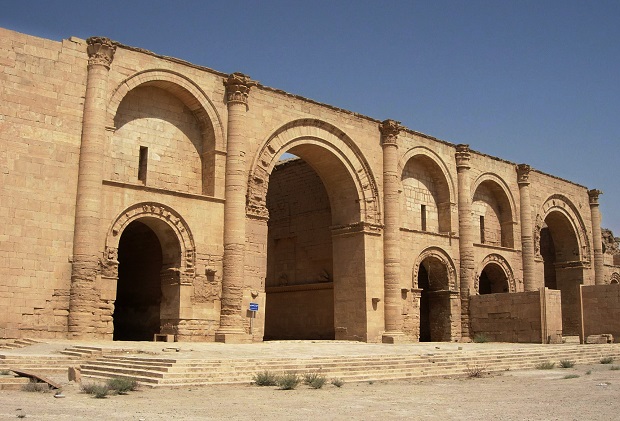
In this July 27, 2005 file photo, a temple to the Shamash sun god still stands over 1,750 years after the Sassanian empire razed the Mesopotamian city of Hatra, 320 kilometers (200 miles) north of Baghdad, Iraq. Iraq’s minister of tourism and antiquities told The Associated Press, Saturday, March 7, 2015, that the government is investigating reports that the ancient archaeological site of Hatra in northwestern Iraq is being demolished by militants from the Islamic State group. The group has already looted artifacts from Nimrud, another ancient archaeological site, on Friday and bulldozed it in a move UNESCO deemed “a war crime.” AP
BAGHDAD, Iraq — Islamic State of Iraq and Syria (ISIS) militants continued their campaign targeting cultural heritage sites in territories they control in northern Iraq, looting and damaging the ancient city of Hatra just one day after bulldozing the historic city of Nimrud, according to Iraqi government officials and local residents.
The destruction in Hatra comes as the militant Islamic group fended off an Iraqi army offensive in Saddam Hussein’s hometown and fought pitched battles in eastern Syria in an area populated by predominantly Christian villages.
Iraqi officials in the northern city of Mosul said Saturday that Islamic State militants have begun demolishing Hatra, a move UNESCO described as “cultural cleansing.”
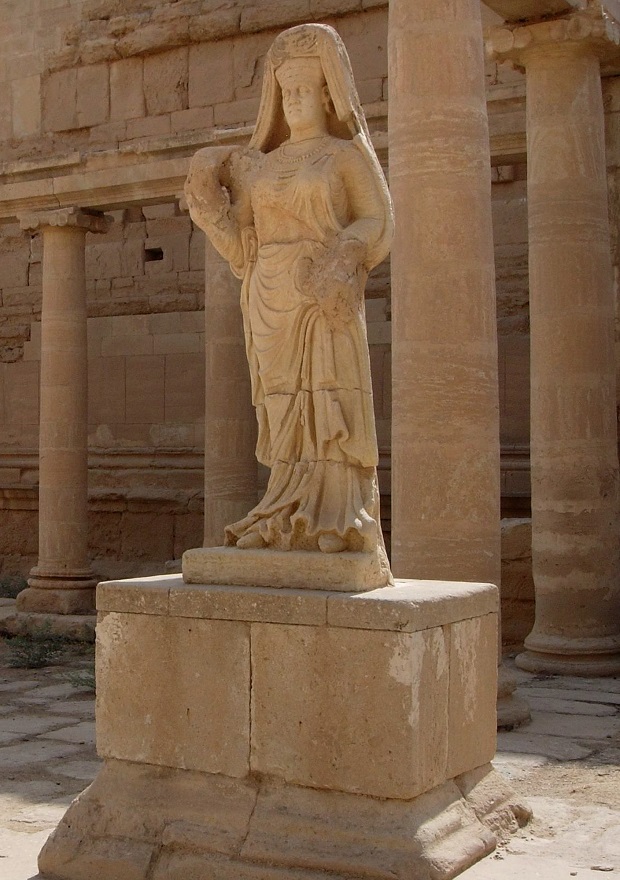
In this file photo taken July 27, 2005, the statue of a robed woman, believed to be the spouse of a former king, stares down at visitors in the ruins of the ancient city of Hatra, 320 kilometers (200 miles) north of Baghdad, Iraq. Islamic State militants control the 2,300-year-old city of Hatra, a well preserved complex of temples south of Mosul and a UNESCO World Heritage site. AP
Large explosions, bulldozers
An official with the ministry of tourism and antiquities’ archaeological division in Mosul told The Associated Press that multiple residents living near Hatra heard two large explosions Saturday morning, then reported seeing bulldozers begin demolishing the site. He spoke anonymously for fear of reprisal.
Saeed Mamuzini, a Kurdish official from Mosul, told the AP that the militants had begun carrying away artifacts from Hatra as early as Thursday and on Saturday, began to destroy the 2,000-year-old city.
Hatra, located 110 kilometers (68 miles) southwest of the city of Mosul, was a large fortified city during the Parthian Empire and capital of the first Arab kingdom. A UNESCO world heritage site, Hatra is said to have withstood invasions by the Romans in A.D. 116 and 198 thanks to its high, thick walls reinforced by towers. The ancient trading center spanned 6 kilometers (4 miles) in circumference and was supported by more than 160 towers. At its heart are a series of temples with a grand temple at the center — a structure supported by columns that once rose to 100 feet.
‘Appalling strategy of cultural cleansing’
“The destruction of Hatra marks a turning point in the appalling strategy of cultural cleansing underway in Iraq,” said Irina Bokova, the director-general of UNESCO, and Abdulaziz Othman Altwaijri, director general of the Islamic Educational, Scientific and Cultural Organization (ISESCO) in a joint statement.
“With this latest act of barbarism against Hatra, (the IS group) shows the contempt in which it holds the history and heritage of Arab people.”
Meanwhile in Syria, Islamic State militants attacked a string of predominantly Christian villages on Saturday, touching off heavy clashes with Kurdish militiamen and their local allies, activists said.
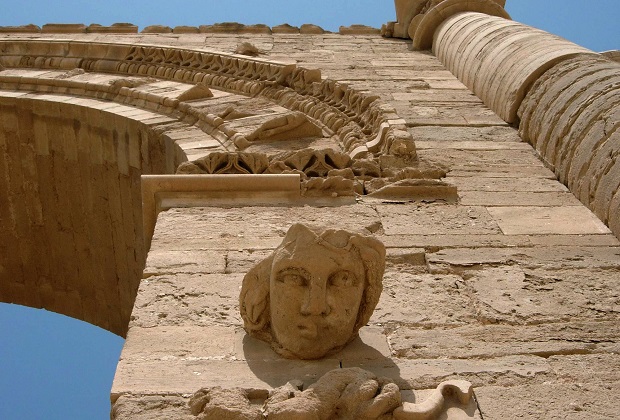
In this July 27, 2005 file photo, the face of a woman stares down at visitors in the Hatra ruins, 320 kilometers (200 miles) north of Baghdad, Iraq. The Iraqi government is investigating reports that the ancient archaeological site of Hatra in northwestern Iraq is being demolished by militants from the Islamic State group. The group has already looted artifacts from Nimrud, another ancient archaeological site, on Friday and bulldozed it in a move UNESCO deemed “a war crime.” AP
Intense, violent fighting
The attack began around dawn and targeted at least three villages near the town of Tal Tamr along the Khabur River in Hassakeh province. The Islamic State group kidnapped more than 220 Assyrian Christians from the same area last month after overrunning several farming communities on the southern bank of the river.
The fighting Saturday was focused in villages on the northern bank of the river as the militants press to capture Tal Tamr, a strategic crossroads some 35 kilometers (20 miles) from the city of Hassakeh, said Osama Edwards, director of the Assyrian Network for Human Rights.
“The battles are now very intensive, very violent,” said Edwards, who is based in Sweden. “Tal Tamr is the main goal of the Islamic State, to give them the corridor to the eastern border to Iraq.”
The Islamic State group currently controls about a third of Iraq and Syria. The Sunni extremist group has been campaigning to purge ancient relics they say promote idolatry that violates their fundamentalist interpretation of Islamic law. A video they released last week shows them smashing artifacts in the Mosul museum and in January, the group burned hundreds of books from the Mosul library and Mosul University, including many rare manuscripts.
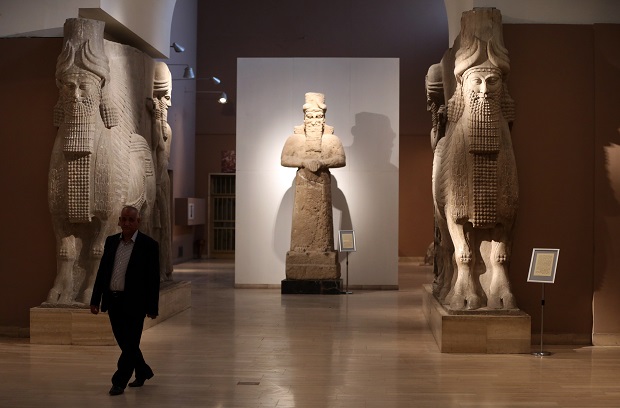
In this March 1, 2015. file photo, a man at Iraq’s National Museum in Baghdad walks past two ancient Assyrian human-headed winged bull statues. Islamic State militants “bulldozed” the renowned archaeological site of the ancient city of Nimrud in northern Iraq on Thursday, March 5, 2015, using heavy military vehicles, the government said. Nimrud was the second capital of Assyria, an ancient kingdom that began in about 900 B.C., partially in present-day Iraq, and became a great regional power. The city, which was destroyed in 612 B.C., is located on the Tigris River just south of Iraq’s second largest city, Mosul, which was captured by the Islamic State group in June. AP
‘A war crime’
The majority of the artifacts destroyed in the Mosul Museum attack were from Hatra.
On Friday, the group looted artifacts from Nimrud, a 3,000-year-old city in Iraq, and bulldozed it in a move United Nations Secretary General Ban Ki-Moon declared “a war crime.”
Iraqi Tourism and Antiquities Minister Adel Shirshab told the AP Saturday that many feared Hatra would suffer the same fate as Nimrud. “This is not unusual (behavior) for Daesh,” Shirshab said, using the Arabic acronym for the group.
A statement on the ministry’s Facebook page Saturday said the government is investigating reports of the attack on Hatra, noting that the global community should hasten its response to the crisis in Iraq in order to prevent these types of atrocities.
Baghdad-based archaeology researcher Junaid Amer Habib said that the destruction of the archaeological sites and artifacts could be “a cover up operation” to disguise efforts to smuggle and sell precious antiquities.
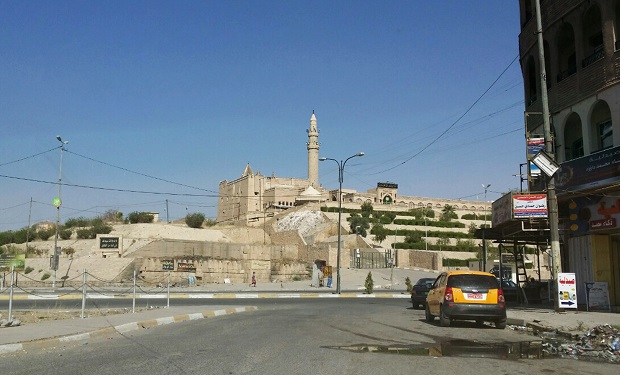
This July 19, 2014, file photo shows the Mosque of The Prophet Younis, or Jonah, in Mosul, 225 miles (360 kilometers) northwest of Baghdad, Iraq. Islamic state militants have destroyed the centuries old Mosque of the Prophet Younis – believed to be the burial place of the prophet Jonah – and the Mosque of the Prophet Jirjis, two revered ancient shrines in Mosul. AP
Artifacts for sale
“These looted artifacts could be a main source of cash for the IS group which lacks cash,” Habib added. “The money generated from such an operation will provide the militants with weapons and salaries.”
Habib said the international community should regulate the illegal trade of precious antiquities on the black market in order to prevent the sale of Iraqi artifacts by the IS group.
Last year, the militants destroyed the mosque believed to be the burial place of the Prophet Younis, or Jonah, as well as the Mosque of the Prophet Jirjis — both revered ancient shrines in Mosul. They also threatened to destroy Mosul’s 850-year old Crooked Minaret, but residents surrounded the structure, preventing the militants from approaching.
A U.S.-led coalition has been striking the Islamic State group since August and is preparing a large-scale operation to retake the city of Mosul. But U.S. and Iraqi officials have been cautious about setting a timeline for preparing Iraq’s embattled military for the campaign.
RELATED STORIES
Pope denounces ‘intolerable brutality’ in Iraq, Syria
Australia warns women ISIS no ‘romantic adventure’














